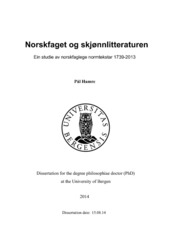| dc.description.abstract | This dissertation is a study of literature as part of the school subject Norwegian. The study has a historical design based on a number of normative texts such as decrees, regulations, laws, curricula, syllabi etc. These texts are seen as the state´s pedagogic steering instruments, expressing the whys, the whats and the hows of teaching literature according to the government´s intentions. The study´s object is Norwegian as school subject at all levels of primary and secondary school and in teacher education. Norwegian as a subject at the universities is not part of the study. The main research question is in what ways the reading of literature has been legitimized as part of mother tongue instruction since 1739. In order to answer this question, the dissertation draws on different theories: hermeneutic theory, formation (Bildung) theory, canon theory and curriculum theory. The dissertation shows that Norwegian as a mother tongue subject originates from two different traditions: (1) In the old primary and lower secondary school (“Allmueskolen”, i.e. compulsory schooling for common people) reading instruction – and its texts – was an instrument in children´s religious education, ending with their confirmation. (2) In the upper secondary school, instruction was based on theology and rhetoric, the classical tradition, and reading was concentrated on Latin and Greek model texts. Towards the end of the 19th century Norwegian as school subject was given its modern form, much like we know it today. In 1884 Johan Sverdrup from the Liberal party (Venstre) became Norway´s first parliamentary prime minister. Two months later he wrote a letter to his own minister of church and education, Elias Blix, a letter he had published in the newspaper Dagbladet. The letter outlined a program for school reform on a national basis. Compulsory education as state schooling was to be strengthened and become a school for everyone, and consequently, teacher education had to be reformed as well. Sverdrup´s letter expressed most of all a will to reform schooling along national lines. In a national context he established Norwegian language and literature as an instrument for uniting Norway into “a well-integrated, harmonious nation”. The literary curriculum was historicized through replacing Roman and Greek Antiquity with the study of mediaeval Old Norse and Norwegian history. Sverdrup´s contribution marked the beginning of what Rune Slagstad has termed “the knowledge regime of the Liberal party state (“venstrepartistaten”). Through various school reforms, Norwegian plays a central part with respect to the government´s view on shaping the individual within the Liberal state. An important instrument in this context was the development of literary readers, especially those of Nordahl Rolfsen´s (published 1892-1895) with 9 million copies printed. The legitimizing of literature was tied to a national context and to a material (Klafki) national Bildung. When the progressive pedagogy came to the front in the 1930s more weight was put on formal Bildung, i.e. student activity, and this led to a weakening of the position of literature, but in the beginning only to a lesser degree. During the 1970s a more radical pedagogical movement led to further weakening. The movement criticized educational nation-building functions, and likewise a cultural heritage thinking that was seen as a reflection of upper and middle class traditions. The position of traditional high literature in Norwegian was challenged by non fiction, popular fiction, working class literature, women´s literature, local literature etc. The 1990s marked a reaction to this in the form of a restorative movement with two elements: (1) a rehabilitation of tradition and high literature and culture, (2) a human capital thinking with a focus on efficiency and education´s contribution to economic growth. In the new millennium, the national building motive has been weakened, and more weight has been put on international and national testing, leading to a stronger concern with the more instrumental uses of Norwegian. At the same time new technologies shape new text forms competing with traditional literature. The dissertation documents high literature´s rise and fall in Norwegian schooling. High literature´s classical period was from 1889 to approx. 1970, with a ten year Renaissance during the 1990s. In the classical period high literature stood its ground as an unchallenged part of Norwegian nation building, most pronounced in Nordahl Rolfsen´s readers with the 1890s as a starting point and with a final flowering in the reforms of Gudmund Hernes in the 1990s. | en_US |
